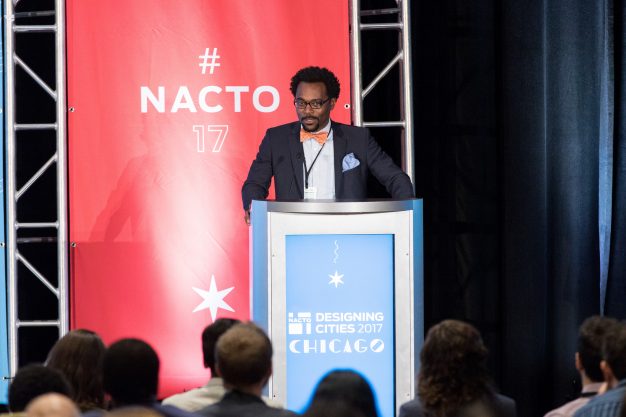
A report from the NACTO Designing Cities Conference
Now in its sixth year, the NACTO Designing Cities Conference brought together 800 officials, planners, and practitioners to Chicago to advance the state of transportation in cities through plenaries, workshops, walkshops and sessions.
The Designing Streets for Kids session, held on October 30th 2017 and presented by Ankita Chachra – Programme Manager at NACTO Global Designing Cities Initiative – explored how learning from young children and their caregivers has had a positive effect on street design, creating more inviting neighbourhoods for all ages.

Highlights
BvLF Programme Director Cecilia Vaca Jones opened the first panel discussion – on “international initiatives and addressing needs” – with a presentation on our Urban95 work, including the idea of children’s priority zones. She explained how the needs of babies and toddlers differ from those of children in general: for example, they are always with caregivers, their range of mobility is shorter, and their bodies and brains are more vulnerable.
Natalie Draisin spoke next about the FIA Foundation’s work on road safety (download the presentation here). According to the WHO, road accidents kill 500 children each day around the world. The FIA commissioned renowned director Luc Besson to make an awareness-raising video as part of the Save Kids Lives campaign, shot on location in South Africa and Paris and showing the dangers faced every day by children on their journey to school.
Including children in the design process
The next panel, on “understanding the user and including children in the design process”, started with Amada O’Rourke – Executive Director of 8 80 Cities – explaining their partnership with BvLF to investigate what cities around the world are doing to engage young children, their families and pregnant women to improve the built environment and delivery of services. You can download their research – with 21 case studies from 16 different countries, identifying innovative and effective techniques – here, and Amanda’s presentation here.
Next, I presented two cases from São Paulo, Brazil. The first was on our new partnership with municipal public authorities through the National Association of Public Transportation (ANTP), in cooperation with Bloomberg Philanthropies, to ensure that young children and families benefit from new mobility infrastructure projects. The pilot will be a new bus corridor in the Campo Limpo district, which will affect access to facilities and services by severing the district longitudinally, but also involve regeneration of a site around a new bus terminal.

We are combining our involvement with our Parents+ strategy work, including the São Paulo Basics campaign and workshops about babywearing.

Reframing road safety
The second case was a study with 3,750 students, aged 6 to 17, from three public schools in São Miguel, São Paulo, as part of urban mobility work with Bloomberg. We are working to change the paradigm of cities being designed with cars as a priority, and children being told that it is up to them to avoid accidents – in line with the Vision Zero approach to reframing road safety as an issue of systems failure. We piloted the Traffic Snake Game – an EU-initiated campaign to encourage primary school children to walk or cycle to school – in one of the three schools, the first time it had been tried outside Europe. Download my presentation here.

The final panel, “designing for children”, was opened by Skye Duncan, Director of the Global Designing Cities Initiative. She explained how the Bloomberg Initiative for Global Road Safety is developing tools to design safer, more sustainable streets for kids of all ages – policy guidance, capacity building and community engagement, data collection and evaluation – in cities including São Paulo and Fortaleza (Brazil), Bogotá (Colombia), Addis Ababa (Ethiopia) and Mumbai (India). BvLF will partner with the initiative to create a guide, Streets for Kids, on street designs to support healthy early childhood development and safe places to learn, play and grow. Download the presentation here.
Conclusions
In closing, Fabrizio Pratti, who coordinates the work of the Global Designing Cities Initiative in Bogotá, explained their main strategy areas: student mobility, Vision Zero pilot areas, the Plaza Programme and improving the Bike to School municipal programme.

After the session, Cecilia Vaca Jones and I joined Kaboom’s “walkshop” through southeast Chicago communities with Aisha Alexander (Director) and Naudy Martínez (Senior Program Manager). Kaboom’s founder, Darell Hammond, is now Senior Advisor for the Bernard van Leer Foundation on the Urban95 strategy and implementation, with a focus on innovations in public space, data management and advocacy. After a great panel, it completed a wonderful experience to have such a beautiful city to explore!

Courtesy of the Bernard van Leer Foundation.





Great to read this overview, which includes several initiatives I had not heard about. It reinforces my view that momentum is growing, and that advocates for children are finding fertile common ground with advocates for more liveable, sustainable urban neighbourhoods. I am pleased to be supporting the work of Irene and her colleagues in Bernard van Leer Foundation, and also Arup, whose report Designing for Urban Childhoods is another important step forward.